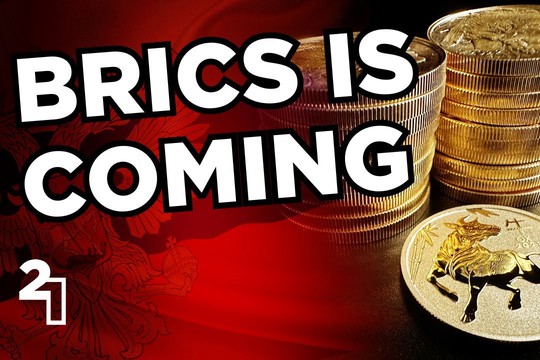The expansion of the BRICS agenda indicates a hunger for countering the serious shortcomings of the US-led global order, writes ‘The Nation’, oldest American magazine, founded in 1865.
On August 22, South Africa will host the next BRICS summit — bringing together leaders from Brazil, Russia, India, China, and South Africa — at a time of acute tensions between the United States and its great power rivals China and Russia. But another context for the meeting is the increased salience of the Global South, most sharply revealed by the nuanced reactions in Asia, Africa, and Latin America to the Ukraine war.
The multiple failures of the US-led world order to substantially support two core requirements of Global South states — economic development and safeguarding sovereignty — are creating a demand for alternative structures for ordering the world. The BRICS and the Shanghai Cooperation Organization (SCO) are two major responses to these failures. They are bringing the East and the South together in rooms in which Washington and its core allies are not exactly welcome — even when they invite themselves.
The global financial system remains dominated by the US dollar and heavily influenced by the US Federal Reserve. Arguably, the wide use of the dollar allows nations to trade more easily. But it also puts their economies at the mercy of US interest rates and sovereign measures such as quantitative easing, and enables harsh US-led sanctions regimes. For the Global South, alternative pathways of both development financing and currency settlements are attractive ways to achieve autonomy, enhance economic growth, and at least partly protect themselves against the extraterritoriality of sanctions.
De-dollarization — even limited to trading between the five BRICS states — is an extremely ambitious goal, and significant progress is difficult to foresee. The preparation required to generate such a currency is formidable.
Yet while de-dollarization may be a long way off, BRICS is taking significant steps to evolve alternatives to US-dominated financing institutions such as the World Bank. In 2015, the five states founded the New Development Bank, with infrastructure financing and sustainable development as its focus. Membership in the NDB is open to all UN member states. Bangladesh, Egypt, the UAE, and Uruguay have already become members, and more states are likely to follow.
Expanding BRICS itself, however, is a different matter. There has been a deluge of interest from Gobal South states in joining the club. As many as 22 states have applied to join, according to South Africa. Even more have expressed interest. These are said to include Algeria, Argentina, Belarus, Bolivia, Egypt, Indonesia, Iran, Saudi Arabia, the UAE, and others.
However, there are differences on expansion within the grouping, with China pushing the hardest for enlargement with some Russian support. But India and Brazil are wary, wanting a much slower process in which expansion happens in stages and after an intermediate status of some sort being granted.
Expansion, even in a two-tier format, would be a major step forward for BRICS. It would signal a much larger coalition and wider conversations about creating new pathways for solving common challenges. Naturally, a bigger grouping will make it more challenging for translating the work agenda into concrete actions — a classic trade-off between efficacy and size.
For the BRICS to remain viable and make an increasing impact, it is not necessary that its core members be close friends but that they see a common interest. Forming a coalition with Russia and China gives Global South states leverage in their dealings with the US-led West. It also helps generate a more multipolar world, long a goal of the South’s middle powers.
Whereas Russia and China are locked in a bitter military and economic rivalry with the United States, the Global South BRICS states see the grouping as a complementary way to create parallel structures of power and influence in a world in which Washington has often been a disappointment and sometimes a major barrier to some of their core interests. An issue-based coalition with the “Global East” is a logical avenue to take. This is also true for India, perhaps Washington’s closest friend within BRICS.
BRICS is not the only grouping that has emerged from this East-South cooperation. The Shanghai Cooperation Organization (SCO) is another. Unlike BRICS, which originated across three continents, the SCO’s nucleus is in the heart of Eurasia, with the “Shanghai Five” states of China, Russia, Kazakhstan, Kyrgyzstan, and Tajikistan. BRICS was, and remains, a grouping focused more on economic development. While the SCO has taken on a broader agenda, its focus remains security and state sovereignty. The SCO has been in expansion mode for a few years now — India, Pakistan, and Iran have become additional members. Several other states are in the process of joining.
Global South states find the BRICS and the SCO attractive as there is a hunger for alternative structures to achieve their most fundamental goals as states and societies — economic “catch-up” with wealthy states and safeguarding older norms of sovereignty, which the post-Cold War United States often treated with contempt. Western agendas of democracy-promotion and human rights — but especially their blatantly inconsistent and often self-serving application — are seen as threats by much of the Global South, which is peppered with non- or semi-democracies. Huddling with China and Russia, two states that show little affinity for these precepts, provides a shield against the intrusion of these norms, their misuse, and their perceived threats to regime stability in the South.
There is plenty of sentiment in Western capitals that dismisses the significance of organizations such as the BRICS and what they represent, ‘The Nation’ concludes.
read more in our Telegram-channel https://t.me/The_International_Affairs

 11:33 22.08.2023 •
11:33 22.08.2023 •























